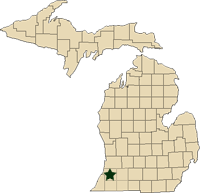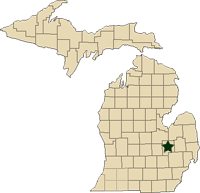Regional reports on Michigan fruit – July 17, 2012
MSU Extension educators’ pest and fruit updates for Michigan.
This week’s regional reports:
- Southwest Michigan - Mark Longstroth, Bill Shane, Diane Brown
- Southeast Michigan - Bob Tritten
Southwest Michigan – Mark Longstroth, Bill Shane, Diane Brown, Michigan State University Extension
|
Weather
Last week was cooler, with highs in the low 90s and lows in the 50s. Scattered rain fell across the region. A few small storms moved through the area on Friday and Saturday (July 13-14). A few areas received 2/10 to 4/10 of an inch, but most areas received less than a tenth if they received any rain at all. Weather for this week is forecast to be hot and remain dry. Rainfall has lagged far behind evaporative demand and all soils are very dry. Because of the heat, our growing degree day accumulations are now two or more weeks ahead of normal according to Enviro-weather. Because of the heat and dryness, many plants are shutting down and little growth is occurring in non-irrigated fields. Annual crops such as corn and soybeans are really stressed and burning up.
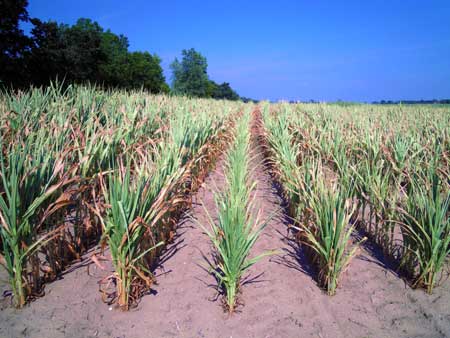
Non-irrigated corn in Van Buren County. Photo credit: Mark Longstroth,MSUE
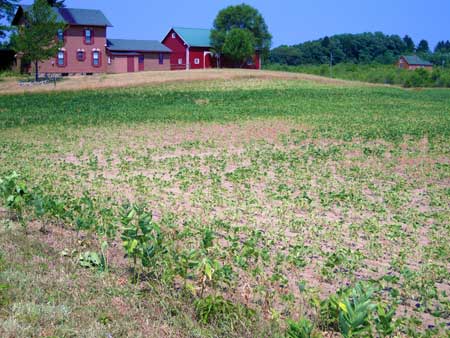
Non-irrigated soybeans in Van Buren County. Photo credit: Mark
Longstroth, MSUE
|
Southwest Michigan Growing Degree Day Totals from January 1 through July 15 | |||
|
Location |
GDD 42 |
GDD 45 |
GDD 50 |
|
2568 |
2234 |
1723 | |
|
2455 |
2122 |
1615 | |
|
Increase since 7/8/2012 |
228 |
203 |
167 |
Be sure and check the MSU Extension Fruit page at the new MSU Extension site for more information.
Small fruit
Japanese beetles are spotty; in some areas they are causing significant injury. Spotted winged Drosophila (SWD) trap numbers were up with cooler temperatures and we can expect their numbers to fluctuate up and down as temperatures go down into the 80s and then rise into the upper 90s. We expect that SWD numbers will continue to increase as the season progresses; under these conditions we can expect a new generation every two or three weeks.
Renovated strawberries are showing good growth where growers have irrigated and little growth where irrigation is lacking. It is very important under these dry conditions to irrigate to maintain good plant growth. Growers should treat the new leaves for potato leafhoppers to prevent this pest from stunting their plants.
Day-neutral strawberries in the high tunnels at the Southwest Michigan Research and Extension Center (SWMREC) are producing good quantities of reasonably- sized berries despite the heat. Spotted wing Drosophila adults were found in these tunnel strawberry plantings for the first time last week. Two adult males were also caught at SWMREC in a trap located near a planting of day-neutral strawberries.
In brambles, summer raspberry harvest is winding down. Size and quality are suffering in the hot, dry weather in irrigated plantings and has shut down in non-irrigated plantings. Summer bramble yields were also reduced by cane injury from spring freezes. Primocanes are now about 3 feet tall. Growers should irrigate to maintain plant and fruit growth.
Growers should be on the lookout for spider mites, Japanese beetles and potato leafhoppers. Spotted wing Drosophila females were trapped in high tunnel blackberry plantings at SWMREC again last week. Spider mites continue to be the primary problem in high tunnel raspberries right now.
Blueberry harvest is moving rapidly in the heat. Fruit quality is generally good. Growers are machine-harvesting Jersey and other midseason varieties. Retaining hand-harvest labor is a problem because of the heat and light yields. Growers report significant fruit losses to birds. Many growers say this is the worst year for birds they can remember. They report birds eating all the blue fruit in fields before they can get in to harvest.
Non-irrigated blueberry fields are burning up and turning brown. Even growers who are irrigating blueberries are having a hard time maintaining adequate soil moisture. Spotted winged Drosophila (SWD) numbers increased with cooler temperatures last week. More growers are spraying for this pest as well as blueberry maggots. See the Blueberry Insect Scouting Report for July 8-14, 2012, for more information. Controls for anthracnose and alternaria fruit rots should be maintained.
Grapes in established vineyards still seem to be growing well and berries are putting on size. In some locations with dry soils, we have begun to see some fruit shriveling. Young vines especially are showing the effects of hot, dry conditions and need supplemental irrigation. Young grape vines do not have the deep extensive root systems of mature vines, and their long-term health can be adversely impacted by drought. Juice grapes are at bunch closure and wine grapes are approaching or are at bunch closure.
Japanese beetle feeding injury remains spotty, about the same last week. Grape berry moth trap catches were light last week. Rates of infestation for vineyards we scout ranged from 4 to 8 percent infested clusters per 25 cluster sample. Grape disease pressure continues to be low. Recent light rainfall may increase humidity, providing more favorable conditions for powdery mildew.
Tree fruit
Most tree fruit in the region are showing drought stress, especially trees with trunk disorders inhibiting water movement. Growers are hauling water to new plantings. Grasshopper damage is common in orchards near grassy fields and tends to be on older leaves. The flight of the second generation of San Jose scale has started. Biofix for the second generation of San Jose scale was set for July 5, based on trap catches of adult males at the Trevor Nichols Research Station in Fennville, Mich. Crawlers of this insect are expected to emerge 300 to 350 DD50 after biofix, approximately Tuesday or Wednesday of this week (July 17-18). If the first generation was not controlled, the second generation is generally a worse problem.
Peaches are showing leaves with yellow stippling due to two-spotted spider mite feeding. Yellowing and dropping of older leaves is common in sandy sites from a combination of stresses. Harvest of pre-Redhaven varieties such as PF 8 Ball, PF 7, Gala and Risingstar is underway. Flagging of branch ends by oriental fruit moth larvae is becoming conspicuous as the heat turns the damaged leaves brown. Oriental fruit moth trap catches continue for the third week of the second generation. Trunk sprays to control peach tree borers are usually applied in late June to early July.
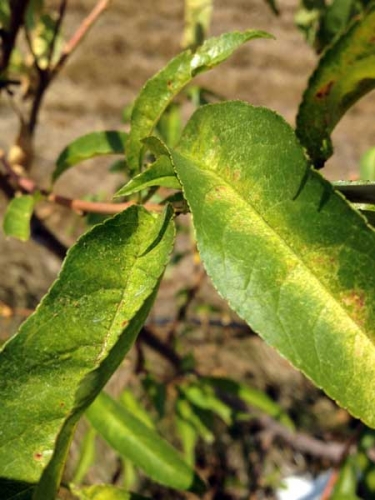
Mite feeding injury on peach leaves. Photo credit: Bill Shane, MSUE
Cherry orchards are dry and cherry leaf spot is not a serious problem in neither sweet nor tart cherries. Post-harvest pruning of mature trees is probably not a good idea where trees are drought-stressed.
Plum tree decline is being seen due to a combination of drought stress and miscellaneous trunk problems. Leaf tattering and shot holes are common due to a wide variety of causes such as earlier frost damage, bacterial infection and physiological causes.
Apple fruits are generally 2.7 or more inches in diameter, with summer apple varieties such as Zestar at 3 inches. Summer apple varieties, especially those with frost marks and cracks, are showing sunscald symptoms on exposed sides of fruit. Codling moth second generation flight was estimated to begin by the end of June. Reports of obliquebanded leafroller feeding in foliage are generally uncommon. Oriental fruit moth second generation moth flight was estimated to begin the second week of June in Berrien County – fruit entries by the larvae are being reported now.
Leaf bronzing from European red mites and rust mites is becoming more common. Rust mites are too small to be detected with the unaided eye. Apple maggot flies have been out for several weeks at relatively low numbers. Dry conditions can inhibit maggot emergence and we expect a spike in numbers if or when we get rain. Powdery mildew symptoms are common and growers should control this disease until terminal bud set, especially in young plantings. Fire blight symptoms, generally uncommon, are easy to see where they occur as dry conditions cause diseased limbs to dry up.
Pear fruit are about 2.5 inches or more in diameter on Harrow Sweet. Rolled leaves due to drought stress are being seen in orchards on sandy sites. Pear psylla is present in low numbers.
Meetings
The 23rd annual Viticulture Field Day will be held at SWMREC on July 25.
The final in-season grape meeting is scheduled for August 14 from 6 to 8:30 p.m. at Bob Dongvillo’s vineyard. More details will be provided in the next report.
Southeast Michigan – Bob Tritten, Michigan State University Extension
|
Weather
Dry soils continue to be a major concern across the region. Most fruit growers report that they have not had significant rain since early May. Fruit growers are starting to see signs of drought stress in established tree and small fruit crops in the last week, and have been seeing signs of drought stress in newly planted tree and small fruit plantings for the last three to four weeks. Drought stress has contributed to cane collapse in summer red and black raspberry plantings, causing many farms to end harvest just as it began. I am seeing signs of drought stress in the form of reduced berry size in blueberries. Growers need to be checking newly planted fruit blocks every few days for signs of drought stress. Growers are devoting a great deal of time to irrigation efforts.
Our early warm season is still running more than two weeks ahead of normal in terms of growth stages, and with all of the heat of last week we are back to being three weeks ahead of normal in terms of degree day totals.
|
East Michigan Growing Degree Day Totals for March 1 to July 16 | |||
|
Location |
GDD42 |
GDD45 |
GDD50 |
|
2456 |
2122 |
1613 | |
|
2428 |
2101 |
1600 | |
|
Flint (Genesee) |
2481 |
2143 |
1636 |
|
2468 |
2139 |
1634 | |
|
2585 |
2244 |
1721 | |
|
2321 |
1998 |
1510 | |
|
2511 |
2177 |
1663 | |
Tree fruits
Apples are close to 2.5 inches in diameter where growers have a crop. Growers continue to summer prune apples.
Where apple growers have a crop this year, I am finding that direct pests are seeking out fruit to feed or breed with a vengeance, resulting in far more fruit damage than growers are accustomed to finding. This has been to case for codling moth and plum curculio and most likely will be the case for apple maggots as well.
Apple maggot trap catch on yellow sticky traps started to be seen on June 30 and high trap catches have continued since then, despite our soils being so dry. Potato leaf hopper leaf curling continues to be very common in unsprayed blocks. Codling moth trap catch has remained steady the last few weeks. Overall, we have had very high numbers of codling moths caught on traps this season. Japanese beetles are being found in increased numbers. European red mite numbers are being kept in check by predators at most farms where there is no crop, however I am seeing some bronzing of leaves in a few trees where growers are controlling pests this season. Some terminal branch flagging from oriental fruit moth is being seen in a few apple blocks, especially in unsprayed blocks.
Powdery mildew-infected terminal branches continue to be prevalent in unsprayed apple blocks. I am encouraging apple growers to keep a close eye on powdery mildew infections in valuable and susceptible varieties, even in blocks with no fruit.
Pear psylla populations have leveled off in unsprayed blocks. Suckers need to be removed to help reduce pear psylla populations.
Peach harvest continues on early varieties. Split pit is still a problem in some varieties. I am seeing yellowing of older leaves in drought areas. I am getting a number of reports of raccoon, squirrel and bird damage to ripening fruit.
Sweet and tart cherry leaf drop from cherry leaf spot disease continues. Japanese beetle feeding is starting to be seen in cherries.
Small fruits
Strawberry fields that were renovated a few weeks ago seem to standing still due to dry soils. Where irrigation is available, it needs to be applied as soon as possible. I am concerned about dry soils in renovated strawberry fields. Potato leafhopper leaf cupping and leaf margin burning is common in many new plantings.
Raspberry harvest for summer fruited types has wrapped up at most farms due to extensive cane collapse caused by a combination of dry soils and freeze damage that has become evident only in the last week. At these farms harvest was less than 10 percent of normal years. Canes of fall bearing types have 36 inches of new growth. Limited harvest on fall bearing types from fruiting lateral canes or bud berries started in the last few days at several farms.
Spotted wing Drosophila trap catch started to be seen two weeks ago at farms that had trap catch last year. We are finding that trap catch declines a bit in hot weather, however it will increase again when cooler temperatures resume. Potato leafhopper feeding injury has caused extensive leaf cupping in many fall raspberry plantings over the last three weeks. Japanese beetles are being found, mostly in fall raspberry plantings.
Blueberry harvest continues. Many varieties are being picked at the same time this season. There does not seem to be as much spread in ripening dates of varieties this year. Berry size is already starting to decline on several varieties, mostly due to drought.
No blueberry maggots have been caught in traps in east Michigan this season, although they are being caught in traps in west Michigan. I usually find that blueberry maggot emerges at the same time as apple maggots, and I started to find apple maggot trap catches on June 30. So, growers need to be on the lookout for it. Japanese beetles are being found, mostly in low to moderate numbers. Remember to check spotted wing Drosophila traps. Bird feeding is extensive at many farms.
Grape berry size is extremely variable this season due to freeze damage that killed most of the primary flower buds. Grape berry moth feeding injury is being found. Japanese beetles are being found, mostly in low to moderate numbers. Grapes have put on a great deal of new growth over the last few weeks.



 Print
Print Email
Email